Ijraset Journal For Research in Applied Science and Engineering Technology
- Home / Ijraset
- On This Page
- Abstract
- Introduction
- Conclusion
- References
- Copyright
Design and Fabrication of Spraying Machine
Authors: Pratham Bante, Shubham Munshi, Saurabh Gawai, Harshal Pote, Shubham Mawande, Swapnil Nimkarde
DOI Link: https://doi.org/10.22214/ijraset.2022.41620
Certificate: View Certificate
Abstract
India is a land of agriculture which comprises of small, marginal, medium and rich farmers. Small scale farmers are very interested in manually lever operated knapsack sprayer because of its versatility, cost and design. But this sprayer has certain limitations like it cannot maintain required pressure; it leads to problem of back pain. However, this equipment can also lead to misapplication of chemicals and ineffective control of target pest which leads to loss of pesticides due to dribbling or drift during application. This phenomenon not only adds to cos of production but also cause environmental pollution and imbalance in natural echo system. This paper suggests a model of manually operated multi nozzle pesticides sprayer pump which will perform spraying at maximum rate in minimum time.
Introduction
I. INTRODUCTION
Agriculture plays a vital role in Indian economy. Around 65% of population in the state is depending on agriculture. Although its contribution to GDP is now around one sixth, it provides 56% of Indian work force. The share of marginal and small farmer is around 81% and land operated is 44 % in 1960-61. As far as Indian scenario is concerned, more than 75 per cent farmers are belonging to small and marginal land carrying and cotton is alone which provide about 80 % employment to Indian workforce. So, any improvement in the productivity related task help to increase Indian farmer’s status and economy.
The current backpack sprayer has lot of limitation and it required more energy to operate. The percentage distribution of farm holding land for marginal farmers is 39.1 percentage, for small farmers 22.6 percentage, for small and marginal farmers 61.7 percentage, for semi-medium farmers 19.8 percentage, for medium farmers 14 percentage and for large farmers 4.5 percentage in year 1960-61. Clearly explain that the maximum percentage of farm distribution belonged to small and marginal category.
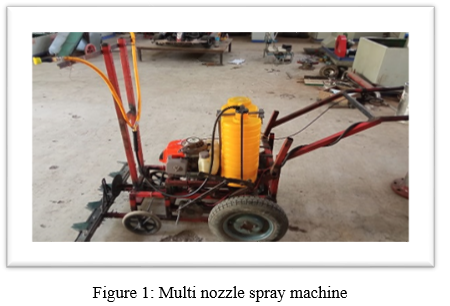
The project is a Pesticide/Fertilizer Sprayer mounted on a Cart which is operated mechanically without any external source of energy.
The aim of developing such a concept is primarily because of preventing the 3 major drawbacks of the pump being used currently Firstly, the farmer has to carry the entire weight of the pesticide spraying (approx. 20+ kg) pump on his shoulder; secondly, he has to continuously use his one hand to pump using the handle; thirdly, reduction in spraying time. All these factors have been taken care of in this project along with being cost effective, light in weight and good in strength. The pump already available with the farmer can be directly used in this mechanism. The handle of the sprayer will be mechanically operated through the rotating shaft of the wheels of the cart using an efficient mechanism. This will result into the reciprocating motion of the piston and hence pumping will be done. The user will now just have to push the cart and the whole mechanism will be operated with ease. This will be a case of Pure Mechanical Automation.
A. Problem Summary
The farmers who use these types conventional backpack sprayer faces many types of problems like fatigue, tiredness, pain in spiral cord and muscles etc. Following problems can take place by use of this conventional type of pump:
B. Common Problems
- Heavy in weight causes difficulty in lifting manually.
- Fatigue to the operator due to heavy weight.
- Due to heavy weight during spraying, operator feel very tiredness and fatigue which reduces his efficiency.
- Big size of pump cause inconvenience to the operator.
- Poor selection and quality of equipment.
- These problems combined with a lack of awareness and technical knowledge and inadequate maintenance and poor field use of equipment has led to unacceptable risks to environment and human health.
II. LITERATURE REVIEW
- R.D. Dhete has worked on “Agricultural fertilizer & pesticides sprayers”. In his work he emphasizes on different method of spraying devices Day by day the population of India is increasing and to fulfil the need of food modernization of agricultural sectors are important. Due to chemical fertilizers the fertility of soil is decreasing. Hence farmers are attracted towards organic farming. By mechanization in spraying devices fertilizers and pesticides are distributed equally on the farm and reduce the quantity of waste, which results in prevention of losses and wastage of input applied to farm. It will reduce the cost of production. It will reduce the cost of production. Mechanization gives higher productivity in minimum input. Farmers are using same traditional methods for spraying fertilizers and pesticides. Equipment is also the same for ages. In India there is a large development in industrial sectors compared to agricultural sectors. Conventionally the spraying is done by labours carrying backpack sprayer and fertilizers are sprayed manually. The efforts required are more and beneficial by farmers having small farming land.
- Pavan B. Wayzode, Sagar R. Umale, Rajat R.Nikam, Amol D.Khadke, Hemant carried out their work in “Design Fabrication of Agricultural sprayers, weed with cutter Chemicals are widely used for controlling disease, insects and weeds in the crops. They are able to save a crop from pest attack only when applied in time. The chemicals are costly. Therefore, equipment for uniform and effective application is essential Dusters and sprayers are generally used for applying chemicals. Dusting, the simpler method of applying chemical, is best suited to portable machinery and it usually requires simple equipment. But it is less efficient than spraying, because of the low retention of the dust. In this work we have proposed an equipment that is wheel and pedal operated sprayer, it is a portable device and no need of any fuel to operate, which is easy to move and sprays the pesticide by moving the wheel and also peddling the equipment. In this equipment using reciprocating pump and there is a accumulator provided for the continuous flows of liquid to create necessary pressure for the spraying action. This wheel operated pesticide spray equipment consumes less time and avoids the pesticide from coming from front of the nozzles which will in contact of the person who sprays pesticides. Weed management is one of the tedious operations in crop production. Because of labour costs, time and fully manual weeding is unfavourable. Hence effort is made to design and develop efficient Farm equipment to perform weeding without using electric power.
- According to literature published on flow control of agricultural spraying machine by massey university Newzeland on different spraying mechanism are studied New Zealand relies heavily on its agricultural industry. A large portion of this industry is pastoral farming, where livestock are raised to graze on pasture. This includes beef, sheep and dairy farming. An important aspect of this style of farming is maintaining pasture quality. In order to increase growth fertilisers are often applied to the pastures. This increase yields in both meat and milk production. However, the increased application of fertiliser is linked with diminishing water quality. While the effects of nitrogen leaching and the best ways to manage fertiliser use are still being investigated, it is clear that control over the application will become more and more important. The Tow and Fert is a range of fertiliser machines designed and built in New Zealand by Metalform Dannevirke. The Tow and Fert range is capable of spraying a wide range of fertilisers including both soluble and non-soluble fertilisers. The Tow and Fert is unique in its ability to spray fertiliser slurries consisting of mixture ratios of up to three-parts fine particle fertiliser to one-part water. This is achieved by the use of a recirculating system. Currently there is next to no control on the flow rate of the machines and the application rate is determined by the speed the operator maintains. The purpose of this thesis is to design and build a flow control system for the Tow and Fert product range and investigate the effect of the changing flow rate on the spray characteristics. The ability to spray such a wide range of fluids with drastically different properties presents many challenges. Many flow meters were considered and a low-cost ultrasonic sensor (TUF2000M) was installed and investigated. After limited success of the ultrasonic sensor, a simple turbine flowmeter was installed. A flow controller was developed and tuned. Based off a PID control loop, the controller was able to maintain flowrate well between 10 L/min and 25 L/min depending on the installed nozzle
- Prof. S.V. Deshpande, Damre Mayur & Diwanale Swapnil has worked on “Agricultural Reciprocating Multi Sprayer”. In agricultural sector generally farmer uses traditional way that is spray carried on backpack and spraying crop. This becomes time consuming, costly and human fatigue is major concern, these problems can be overcome by using agricultural reciprocating multi sprayer. It facilitates uniform spread of the chemicals, capable of throwing chemicals at the desired level, precision made nozzle tip for adjustable stream and capable of throwing foggy spray depending on requirement. In our project we use slider crank mechanism to convert rotary motion into reciprocating motion to operate the pump, thus the pesticide is spread through the nozzle. This work gives continuously flow of pesticide at required pressure and height. A special arrangement is implemented in this project to adjust the pressure as high or low. We also use a weed cuter in our model for removing unwanted plants. By using agricultural sprayer, spraying time and weeding time, human efforts reduces and results in cost reduction.
III. OBJECTIVES
A. Aim of this project is that the farmer need not carry the entire pesticide sprayer pump on his shoulders but just pull/push the mechanism mounted on the trolley to operate the pump and spray the pests. This makes the farmer feel comfortable, relaxed and less tiresome.
B. To reduce human efforts due to the constant pumping action for creating pressure inside the pesticide sprayer and thereby provide a suitable environment for the user reducing the fatigue load acting on the body. As discussed previously, the farmer has to continuously keep on pumping using one of his hands and spray the pests on the crops using the other hand. This at a long run is a tiresome and cumbersome job and the farmer slowly loses interest from it.
C. This project focuses on the problem of health-related issues of the farmer (operator). Majority of them don’t use any precautions like face-masks and hand-gloves against the hazardous chemicals and work in direct contact with it. Consequently, this harms the farmer as the spray in the conventional method directly hits the face. Multi-nozzle is used and hence larger area of field can be sprayed at faster rate.
IV. METHODOLOGY
- The working of spraying machine is based on four bar chain mechanism. Transmission of power to this mechanism is done by 2 bevel gears which are attached at the end of engine & shafts at right angle. A disc is attached to the another end of shaft which will act as a crank for four bar chain mechanism.
- A connecting rod will transfer this rotary motion of crank into the reciprocating motion of the rocker of spraying tank. In this power is given to piston of reciprocating pump through rotation of wheel.
- When piston reach at top dead centre, it creates negative or low pressure inside the cylinder due to pressure difference between reservoir and cylinder space, water moves to fill the cylinder chamber space. In this process suction valve open and delivery valve close.
- When piston reaches at bottom dead centre, it creates high pressure inside the cylinder chamber & due to the pressure difference between cylinder & delivery pipe. Water moves through discharge pipe to sprinkle. In this process suction valve closed and delivery valve open. This process repeats again and again to get desire output
A. Four Bar Mechanism
A four bar linkage is also called as four bar is a simplest movable chain linkage. It consists of four bodies, bar or links. These links are connected by a group of 4 joints
Pascal’s law: in a fluid at rest in a closed container, a pressure change in one part is transmitted without loss to every portion of the fluid and to the walls of the container.
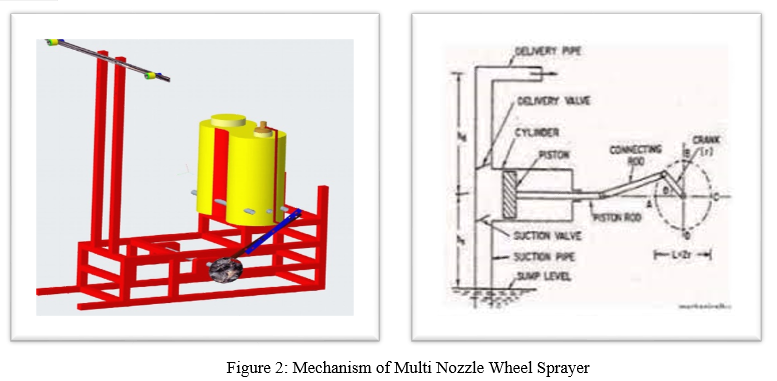
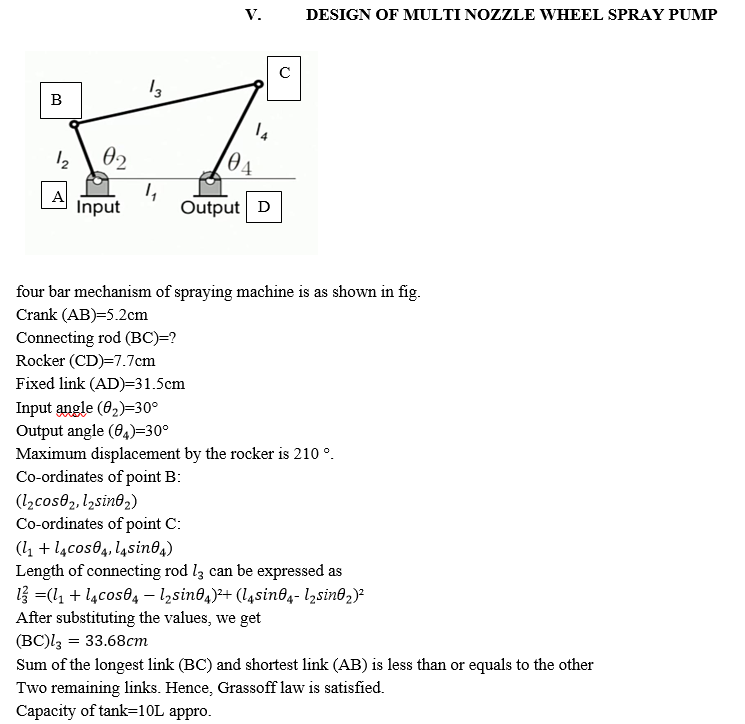
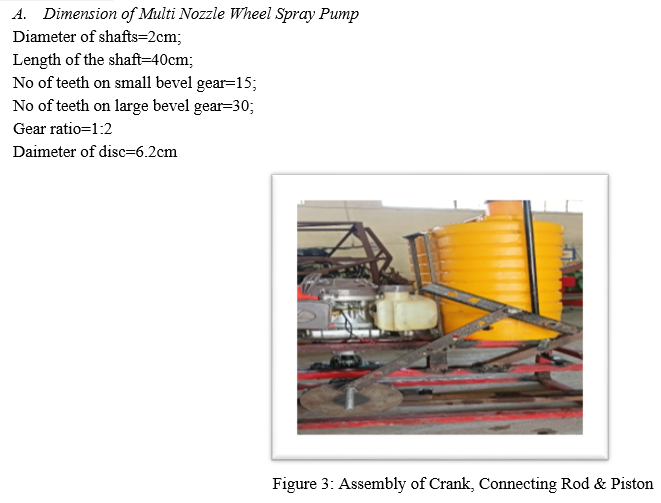
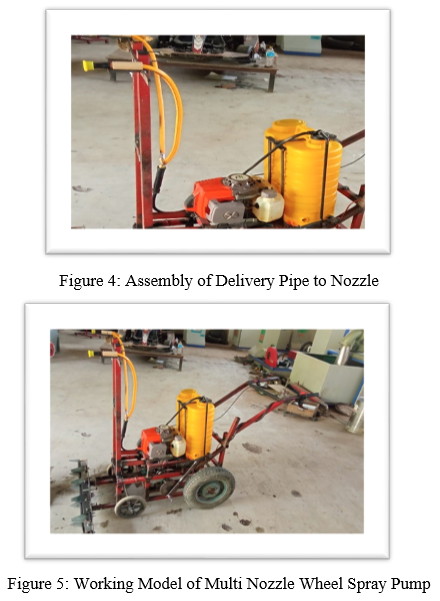
VI. APPLICATIONS
- Its major use in agriculture to spray fertilizer.
- In city and urban area, it can use for spraying water on lawn.
- It may be exercise device at morning during utilize in lawn.
- Use from spray chemical Pesticide in plants in farm.
- It is use for spray painting in industry.
- It is use for spray water in garden on the plants.
- It is use for transfer water from one place to its nearer place.
- For the insecticides application to control insect pests on crops and in stores, houses, kitchen, poultry farms, barns, etc.
- For the fungicides and bactericides application to control the plant diseases.
- For the herbicide’s application, to kill the weeds.
- For the harmony sprays application to increase the fruit set or to prevent the premature dropping of fruits.
- For the application of plant nutrients as foliar spray.
- For applying the powdery formulation of poisonous chemicals on the crops and for any other purposes.
A. Advantages
- It does not require any kind of non-renewable energy is mechanical, electrical and pressure energy.
- It reduces the fatigue of operator during the operation.
- It increases the efficiency of operator
- It can cover more area of land during spray.
- It can adjust the height of spray by using adjustable
- Its cost is less than electrically and solar operated pump.
- It has is less air pollution.
B. Disadvantages
- In rainy days in muddy environment it is difficult to operate.
- In irregular area of land, it can difficult to operate.
- For irregular crops this pump is difficult to work.
- The flow is not uniform, so we have to fit a bottle at both ends.
- The flow is very less & Can't be used for high flow operation.
VII. FUTURE SCOPE
The gear ratio we have used in this project is 1:2 which can be varied according to the need and design in order to obtain variety of performances in the sprayer. More number of nozzles can be utilized. Higher capacity bag pack sprayer can be used.
VIII. RESULTS
A. Manual Harvesting Cost
Amount paid to the labour for one day - Rs 300 per labour Total number of labour required in general to spraying I acre farm-6
Total amount paid to the labour-6*300-Rs.1800
Total cost in one day-Rs. 1800.
B. Harvesting cost using Crop Reaper
Quantity of petrol require for 1 to 1 acre = 4 litre
Cost of petrol per litre =Rs.121
Total cost of petrol for 1 acre farm for a day=4*121=484
Amount paid to the labour = Rs.300
Total cost = Total cost of petrol + Amount paid to the labour + Maintenance
-484+300+150
-934
Amount saved by one day =1800-934
=Rs 866
Conclusion
1) The suggested model has removed the problem of back pain, since there is no need to carry the tank on the backbone 2) and solder. 3) More no. of nozzle which cover maximum area of spray in minimum time at maximum rate. 4) Proper adjustment facility in the model with respect to crop helps to avoid excessive use of pesticides which result 5) into less pollution. 6) Imported hollow cone nozzle should be used in the field for the better performance. 7) Muscular problem is removed and there is no need to operate lever. 8) This alone pump can use for multiple crops. 9) After having a trial, we have found that one finds it easy to operate push type machine. 10) The pump can deliver the liquid at sufficient pressure where output of the nozzle in1min is 0.3 and spray width 0.4m 11) from calculation so that it reaches all the foliage and spreads entirely over the spray surface. 12) It is little heavy but efficiently working in rough conditions of farm. It is economical therefore affordable for all 13) kind of farmers. 14) It requires comparatively less time for spraying so we can get more fields spraying per day. It is cost effective 15) than the existing spraying pumps available in the market as no direct fuel cost or cost for maintenance is needed for this. 16) It is upgraded design of manually operated sprayer and weeder which will be helpful for small land farmers. 17) It consumes less time and saves money as compared with conventional spraying and weeding. 18) This machine does not require any fuel or power so maintenance is less.
References
[1] R. Joshua, V. Vasu and P. Vincent. (2010) “Solar Sprayer - An Agriculture Implement”, “International Journal of Sustainable Agriculture 2 (1): pp. 16-19, ISSN 2079-2107” [2] M. A. Miller, B. L. Steward, M. L. Westphalen “Effects of multi?mode four?wheel steering on sprayer machine performance”, American Society of Agricultural Engineers ISSN 0001?2351 [3] R. D. Fox, R. C. Derksen. (2003) “Visual and image system measurement of spray deposits using water–sensitive paper Applied Engineering in Agriculture Vol. 19(5): pp. 549–552. American Society of Agricultural Engineers ISSN 0883–8542. [4] Laukik P. Raut, Smit B. Jaiswal, Nitin Y. Mohite. (2013, Nov.) “Design, development and fabrication of agricultural pesticides sprayer with weeder”,International Journal of Applied Research and studies(IJARS), pp. 1-8, ISSN: 2278-9480. [5] Application technology: Problems and opportunities with Knapsack sprayer, Including the critical flow valves or Constant Flow Valves. - David McAuliffe and Vanessa P. Gray. [6] Journal of arboriculture weed control in landscape plantings1 by J.F. Ahrens April 1981 vol. 7, no. 4. [7] Backpack Sprayer-Modified for small farm Crop Protection-Rutgers Snyder Research & Extension Farm Staff–Edited by John Grande and Jack Rabin. [8] To Spray or Not to Spray: Pesticides, Banana Exports, and Food Safety John S. Wilsona Tsunehiro Otsuki*, b a b Development Research Group (DECRG), World Bank, 1818 H Street NW, Washington, D.C. 20433, USA March 2002. [9] Farmers understanding of pesticides safety labels and field spraying practices. By Oluyede Clifford Ajayi and Festus K. AkinnifesiScientific Research and Essay Vol (2), pp.204-210, June 2007 ISSN 1992-2248@2007 Academic Journals [10] Wilcoz. M. 1969. A sprayer for application of small amounts of herbicides to flats. Weed Sci. 17:263- 264
Copyright
Copyright © 2022 Pratham Bante, Shubham Munshi, Saurabh Gawai, Harshal Pote, Shubham Mawande, Swapnil Nimkarde. This is an open access article distributed under the Creative Commons Attribution License, which permits unrestricted use, distribution, and reproduction in any medium, provided the original work is properly cited.

Download Paper
Paper Id : IJRASET41620
Publish Date : 2022-04-19
ISSN : 2321-9653
Publisher Name : IJRASET
DOI Link : Click Here
 Submit Paper Online
Submit Paper Online

